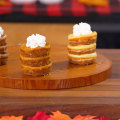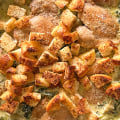Chef notes
Originally a nutritional powerhouse of Indigenous North America, succotash was a brothy, long-simmered dish, defined by two critical ingredients: dry corn, hulled by steeping in wood-ash lye (known as whole hominy or pozole today), and dry beans. Upon this savory background was layered an ever-varying array of fish, shellfish, meat, roots, nuts, fruits and leaves; the results simmered up in the kettle would never be exactly the same twice.
As someone who studies food history to learn about cultural transitions, I developed this particular version of the recipe as a practical exercise in imagination, exploring what may have resulted when early English colonizers, themselves an avid broth-cooking people, took on this Indigenous food and seasoned it with their own flavorings and garnishes.
My passion for succotash is stoked by the knowledge that some of my neighbors here in Plymouth, Massachusetts, still to this day eat — and find meaning in — a particular version of this venerable dish. This plant-based succotash, full of autumnal ingredients, however, resembles that one not at all! A testament to the enormous flexibility of the concept — once you have the corn and beans in the kettle, the rest is really up to you and what you can rustle up in the garden, the woods, the farmers' market or your own imagination.
Technique tip: You can make a perfectly good succotash on your stovetop, but try stirring it up over an outdoor fire or in your fireplace for an unforgettable experience and a good introduction to the fun of live-fire cooking. All you need is a heavy pot — cast-iron is ideal — and a couple bricks. Set the bricks on edge in a stable place near the fire, just far apart enough to support the pot well. Then use a shovel or poker to drag plenty of coals underneath. Keep your main fire burning so that you'll be able to replenish coals as needed. The recipe works the same regardless of heating technology.
Swap option: You can omit every ingredient except hulled corn, beans and water, and still call it succotash. Create your own signature version!
Learn more about outdoor cooking from my book "Cooking with Fire."
Ingredients
- 2 pounds cooked, hulled corn (reconstituted dry whole hominy, frozen hominy or pozole)
- 8 ounces dry beans (such as cranberry, jacob's cattle, great northern), soaked and pre-cooked in water until just tender
- sea salt, to taste
- 2-3 turnips and/or carrots, chopped
- 1 acorn squash, seeded and sliced (or another favorite hard squash or sugar pumpkin)
- 2-3 cups chopped cabbage, collards or turnip greens
- 1-2 leeks or onions, sliced
- 2-3 cups chopped lettuce, spinach, endive, chicory and/or arugula
- 1 cup ground or finely chopped seeds and/or nuts (hulled pumpkin or sunflower seeds, walnuts, chestnuts or hazelnuts)
- 1 bunch chives or scallions, chopped
- freshly ground black pepper, to taste
- 1 fistful calendula petals (optional)
- 1/2-1 cup chopped fresh mint and/or parsley leaves
Preparation
1.In a large soup pot, stir together the pre-cooked hominy corn and pre-cooked beans. Top up with plenty of water if their accompanying cooking liquid doesn't offer full coverage — the beans and corn should be submerged by an inch or so. Add a teaspoon of salt and place over medium heat on your stove, or better yet, over a gentle fire in your fireplace or firepit.
2.Once the mixture has come to a simmer, add turnips, carrots, squash, cabbage, collards or greens, and onions or leeks. Cook until vegetables are just tender (this may take from 15 to 30 minutes, depending on the ingredient choices you've made).
3.Add the chopped tender greens (lettuce, spinach, endive, chicory, arugula), the nuts/seeds and the scallions or chives, and bring to a simmer. Season with pepper and correct the salt.
4.Stir in the calendula petals and the chopped herbs just before serving.













